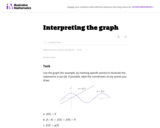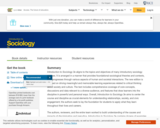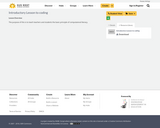
This real world task requires students to compare differing interest rates.
- Subject:
- Math
- Material Type:
- Activity/Lab
- Provider:
- Illustrative Mathematics
- Provider Set:
- Illustrative Mathematics
- Author:
- Illustrative Mathematics
- Date Added:
- 05/01/2012

This real world task requires students to compare differing interest rates.

This week, Stan Muller teaches you how intellectual property law functions internationally. Like, between countries. Well, guess what. There's kind of no such thing as international law. But we can talk about treaties. There are a bevy of international treaties that regulate how countries deal with each others' IP. The upside is that this cooperation tends to foster international trade. The downside is, these treaties tend to stifle creativity by making it harder to shorten copyright terms. You win some, you lose some.

This division task asks studnets to consider the conceptual understanding of something usually taught as a rote procedure. To be successful with this task, students must make sense of the procedure and how place value is represented and abbreviated within it.

The purpose of this task is to help students learn to read information about a function from its graph, by asking them to show the part of the graph that exhibits a certain property of the function. The task could be used to further instruction on understanding functions, or as an assessment tool with the caveat that it requires some amount of creativity to decide how to best illustrate some of the statements.

This problem provides an opportunity to experiment with modeling real data. Populations are often modeled with exponential functions and in this particular case we see that, over the last 200 years, the rate of population growth accelerated rapidly, reaching a peak a little after the middle of the 20th century and now it is slowing down.

This task rquires students to determine if linear functions would be useful to model relationships presented in a data table.

While building and testing model rockets fueled by antacid tablets, students are introduced to the basic physics concepts on how rockets work. Students revise and improve their initial designs. Note: This activity is similar to the elementary-level film canister rockets activity, but adapted for middle school students.

Acting as if they are biomedical engineers, students design and print 3D prototypes of pressure sensors that measure the pressure of the eyes of people diagnosed with glaucoma. After completing the tasks within the associated lesson, students conduct research on pressure gauges, apply their understanding of radio-frequency identification (RFID) technology and its components, iterate their designs to make improvements, and use 3D software to design and print 3D prototypes. After successful 3D printing, teams present their models to their peers. If a 3D printer is not available, use alternate fabrication materials such as modeling clay, or end the activity once the designs are complete.

This week, Stan Muller launches the Crash Course Intellectual Property mini-series. So, what is intellectual property, and why are we teaching it? Well, intellectual property is about ideas and their ownership, and it's basically about the rights of creators to make money from their work. Intellectual property is so pervasive in today's world, we thought you ought to know a little bit about it. We're going to discuss the three major elements of IP: Copyright, Patents, and Trademarks.

This task lets students explore the differences between linear and non-linear functions. By contrasting the two, it reinforces properties of linear functions. The task lends itself to an extended discussion comparing the differences that students have found and relating them back to the equation and the graph of the two functions.

Introduction to Sociology is intended for a one-semester introductory sociology course. Conceived of and developed by active sociology instructors, this up-to-date title and can be downloaded now by clicking on the "Get this book" button below. This online, fully editable and customizable title includes sociology theory and research; real-world applications; simplify and debate features; and learning objectives for each chapter

The purpose of this is to teach teachers and students the basic principle of computaional literacy.

Adjectives are the words we use to modify nouns. هتDavid explains how, with the help of a bear.

Students learn about radar imaging and its various military and civilian applications that include recognition and detection of human-made targets, and the monitoring of space, deforestation and oil spills. They learn how the concepts of similarity and scaling are used in radar imaging to create three-dimensional models of various targets. Students apply the critical attributes of similar figures to create scale models of a radar imaging scenario using infrared range sensors (to emulate radar functions) and toy airplanes (to emulate targets). They use technology tools to measure angles and distances, and relate the concept of similar figures to real-world applications.

When students plot irrational numbers on the number line, it helps reinforce the idea that they fit into a number system that includes the more familiar integer and rational numbers.

To better understand electricity, students investigate the properties of materials based on their ability to dispel static electricity. They complete a lab worksheet, collect experimental data, and draw conclusions based on their observations and understanding of electricity. The activity provides hands-on learning experience to safely explore the concept of static electricity, learning what static electricity is and which materials best hold static charge. Students learn to identify materials that hold static charge as insulators and materials that dispel charge as conductors. The class applies the results from their material tests to real-world engineering by identifying the best of the given materials for moving current in a solar panel.

The goal of this activity is to understand how techniques of persuasion (including background, supporting evidence, storytelling and the call to action) are used to develop an argument for or against a topic. Students develop an environmental case study for presentation and understand how a case study is used as an analysis tool.

Students will brainstorm ways that they use and waste natural resources. Also, they will respond to some facts about population growth and how people use petroleum. Lastly, students will consider the different ways that engineers interact with and use our natural resources.

In this activity, students will conduct a survey to identify the environmental issues (in their community, their country and the world) for which people are concerned. They will tally and graph the results. Also, students will discuss how surveys are important when engineers make decisions about environmental issues.

In this activity, students will learn to identify different opinions related to an issue as well as the things (information, values and beliefs) that influence those opinions. They will use an opinion spectrum to analyze the range of opinions in their classroom on environmental issues and understand how these spectrums can be valuable to engineering design.